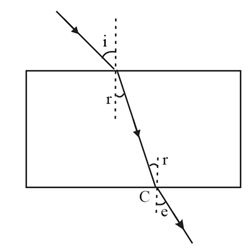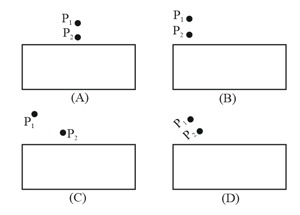A ray of light falls on a plane mirror at an angle . After reflection, the angle of deviation is

Important Questions on Light : Reflection and Refraction
A convex lens is distinguished from a concave lens by the property of
A student does the experiment on tracing the path of a ray of light passing through a rectangular glass slab for different angles of incidence. He can get a correct measure of the angles of incidence and angles of emergence by following the label indicated in figure.

If a ray of light passes along the principal axis of a convex lens, it
While performing the experiment on tracing the path of a ray of light passing through a glass slab as shown in the figure, four students interpreted the results as given. Choose the correct option.

Four students reported the following observation tables for the experiment to trace the path of a ray of light passing through a glass slab for different angles of incidence. The observation likely to be correct are those of student.
Which of the following set of materials represents the minimum material required for determining the focal length of a convex lens by obtaining the image of a distant object on a screen in your school laboratory.
(i) Set A - A candle, a match box, convex lens, a lens holder, a screen with stand.
(ii) Set B - A lens holder, a convex lens a concave lens, a measuring scale.
(iii) Set C - A convex lens, a lens holder, a screen with a stand, a measuring scale.
(iv) Set D - A convex lens, a burning candle, a screen with stand, a lens holder.
While tracing the path of ray of light passing from air through a rectangular glass slab, the setup, in which the best result will be obtained is

A student performs the experiment on tracing the path of ray of light passing through a rectangular glass slab for different angles of incidence. He measures the angle of incidence , angle refraction and angle of emergence for all his observations. He would find that in all cases.
